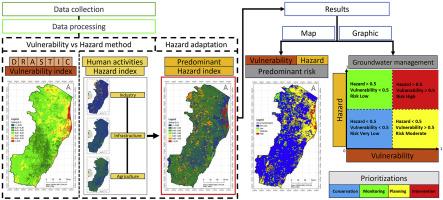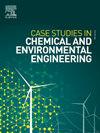A framework model to prioritize groundwater management actions based on the concept of dominant risk: An application to the state of Espírito Santo, Brazil
Q1 Environmental Science
Case Studies in Chemical and Environmental Engineering
Pub Date : 2024-11-28
DOI:10.1016/j.cscee.2024.101032
引用次数: 0
Abstract
The objective of this study was to assess the risk of groundwater contamination in the state of Espírito Santo (Brazil), with a focus on the city of Vitória (the state capital), based on the so-called “Vulnerability versus Hazard” method. This method consists in assessing the risk of groundwater contamination using as base data the intrinsics's aquifer vulnerability and the main human activities as proxies of hazards. The assessment based on this approach results in a quadrant system that links different levels of risk to different management priorities, allowing the implementation of mitigating actions according to the identified level of risk. In this study, the method was adapted to identify a dominant risk, which was the most impacting among the hazards related with industrial, infrastructure or agricultural activities. The results showed a dominant risk map with significant levels classified as high and moderate in the northern regions and along the coast of Espírito Santo state, due to the concentration of various human activities. In the Vitória's metropolitan and southern regions of the state, the risk of contamination was lower, due to the characteristics of soil and the presence of fractured aquifers that act as natural barriers. However, there were exceptions, such as between Alegre and Castelo areas, which indicated incidental threats to public health due to human activities. The analysis of Vitória municipality showed 46.9 % of the area at very low risk, 5.5 % at low risk, 35 % at medium risk and 12.6 % at high risk. It is noteworthy that 47.6 % of this municipality is already at a moderate or high-risk level, highlighting significant environmental challenges around the Santa Maria River, the Vitória airport area and the Camburi beach. Overall, the study of groundwater contamination risk in the state of Espírito Santo revealed a challenging scenario, highlighting the urgency of effective actions to promote environmental resilience in Vitória.

基于主导风险概念的地下水管理行动优先排序框架模型:巴西圣托Espírito州的应用
本研究的目的是评估Espírito Santo州(巴西)地下水污染的风险,并以Vitória市(州首府)为重点,基于所谓的“脆弱性与危害”方法。该方法以含水层脆弱性为基础数据,以主要人类活动为危害指标,对地下水污染风险进行评估。基于此方法的评估产生了一个象限系统,该系统将不同级别的风险与不同的管理优先级联系起来,允许根据识别的风险级别实施减轻行动。在本研究中,该方法被用于识别与工业、基础设施或农业活动相关的危害中影响最大的显性风险。结果显示,由于各种人类活动的集中,北部地区和Espírito Santo州沿海地区的显著水平被划分为高和中等。在Vitória的大都市和南部地区,污染的风险较低,这是由于土壤的特性和裂缝含水层的存在,它们起到了天然屏障的作用。然而,也有例外,例如在阿雷格里和卡斯特洛地区之间,这表明人类活动对公共健康造成了偶然的威胁。Vitória市分析显示,46.9%的地区为极低风险区,5.5%为低风险区,35%为中等风险区,12.6%为高风险区。值得注意的是,该市47.6%的地区已经处于中等或高风险水平,突出了圣玛丽亚河、Vitória机场区和坎布里海滩周围的重大环境挑战。总体而言,对Espírito Santo州地下水污染风险的研究揭示了一个具有挑战性的情景,强调了采取有效行动促进Vitória州环境恢复力的紧迫性。
本文章由计算机程序翻译,如有差异,请以英文原文为准。
求助全文
约1分钟内获得全文
求助全文
来源期刊

Case Studies in Chemical and Environmental Engineering
Engineering-Engineering (miscellaneous)
CiteScore
9.20
自引率
0.00%
发文量
103
审稿时长
40 days
 求助内容:
求助内容: 应助结果提醒方式:
应助结果提醒方式:


